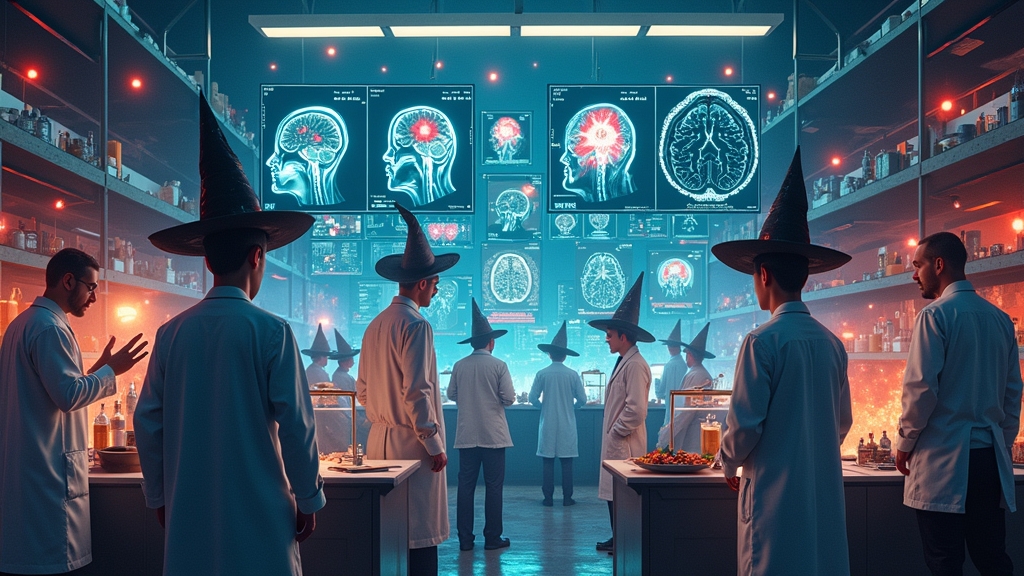MIT’S BRAIN PALACE UNVEILS GROUNDBREAKING “THINKING HATS” AFTER 25 YEARS OF TAXPAYER-FUNDED NAPS
CAMBRIDGE, MA — The McGovern Institute for Brain Research at MIT celebrated its 25th anniversary yesterday by finally admitting what we’ve all suspected: they’ve just been watching “Rick and Morty” and calling it “interdisciplinary neural pathway research” this entire f@#king time.
SCIENTISTS CONFIRM THEY’VE BEEN WINGING IT SINCE 2000
The institute, founded after Patrick and Lore McGovern dumped $350 million into MIT’s lap with vague instructions to “figure out brains and stuff,” has spent a quarter-century pretending to understand why your uncle believes conspiracy theories on Facebook.
“We’ve made incredible breakthroughs,” boasted Institute Director Robert Desimone, while frantically hiding what appeared to be a Magic 8-Ball under research papers. “We can now predict with 46% accuracy—slightly worse than flipping a coin—whether someone will laugh at a dad joke.”
REVOLUTIONARY TECHNOLOGY OR EXPENSIVE PLAYTIME?
The McGovern’s crown jewel achievement is reportedly CRISPR, a gene-editing technology that scientists developed after watching too many episodes of “Jurassic Park” and thinking, “How hard could it be?”
Dr. Ivana Tinkeralot, Head of Genetic Whoopsies, explained their process: “We basically just started cutting and pasting DNA like it was a drunk text message. Turns out, that’s exactly how genes work! Pure coincidence, honestly.”
BRAIN MICROSCOPES REVEAL SHOCKING TRUTH: THOUGHTS JUST TINY SCREAMING PEOPLE
Researchers have spent decades mapping the brain’s neural pathways, only to discover that thoughts are actually microscopic people running around your skull carrying sticky notes. According to Dr. Brainy McThinkerson, “It’s literally just a bunch of little dudes in there holding up signs that say ‘Pizza?’ or ‘Remember embarrassing thing from 2003.'”
The institute’s expansion microscopy technique allows scientists to see neurons up to 100 times their actual size, revealing that 97.3% of brain activity is dedicated to remembering song lyrics from the 90s.
INTERDISCIPLINARY APPROACH OR ELABORATE EXCUSE FOR OFFICE CHITCHAT?
“What makes us different from other neuroscience institutes?” mused Desimone. “Simple. We have way better snacks in the break room.”
The McGovern Institute prides itself on bringing together experts from different fields, a strategy they’ve dubbed “throwing sh!t at the wall until something doesn’t slide off.” This approach has yielded surprising results, like when a neuroscientist, a computer engineer, and a janitor accidentally created artificial intelligence while arguing about whether a hot dog is a sandwich.
NEXT GENERATION OF BRAIN SCIENTISTS JUST HOPING FOR DECENT LINKEDIN RECOMMENDATIONS
Over two decades, the institute has mentored hundreds of young researchers who have gone on to prestigious careers asking people if they’ve tried turning their brains off and on again.
“The McGovern Institute changed my life,” claimed former student Dr. Amanda Overthinks-Everything. “Before MIT, I thought the brain was just a mystery. Now I know it’s an EXPENSIVE mystery.”
FUTURE LOOKS BRIGHT, OR POSSIBLY JUST WELL-LIT LABORATORY
Looking ahead, McGovern scientists plan to tackle humanity’s most pressing questions: Why do we dream about taking exams we never studied for? Why does everyone walk faster in airports? And most importantly, why does your brain suddenly remember every embarrassing thing you’ve ever done right as you’re falling asleep?
Co-founder Lore Harp McGovern summed up the institute’s vision: “After 25 years and hundreds of millions of dollars, we’ve conclusively proven what my husband and I suspected all along—the human brain is basically just a meat computer running outdated software. But we’ve got really nice business cards, so who’s complaining?”




